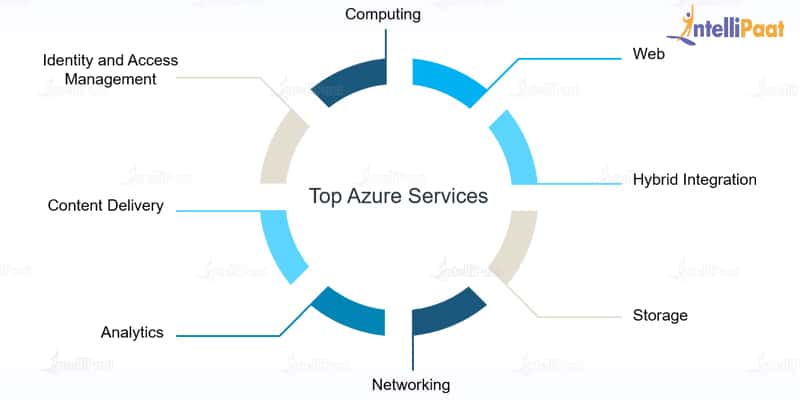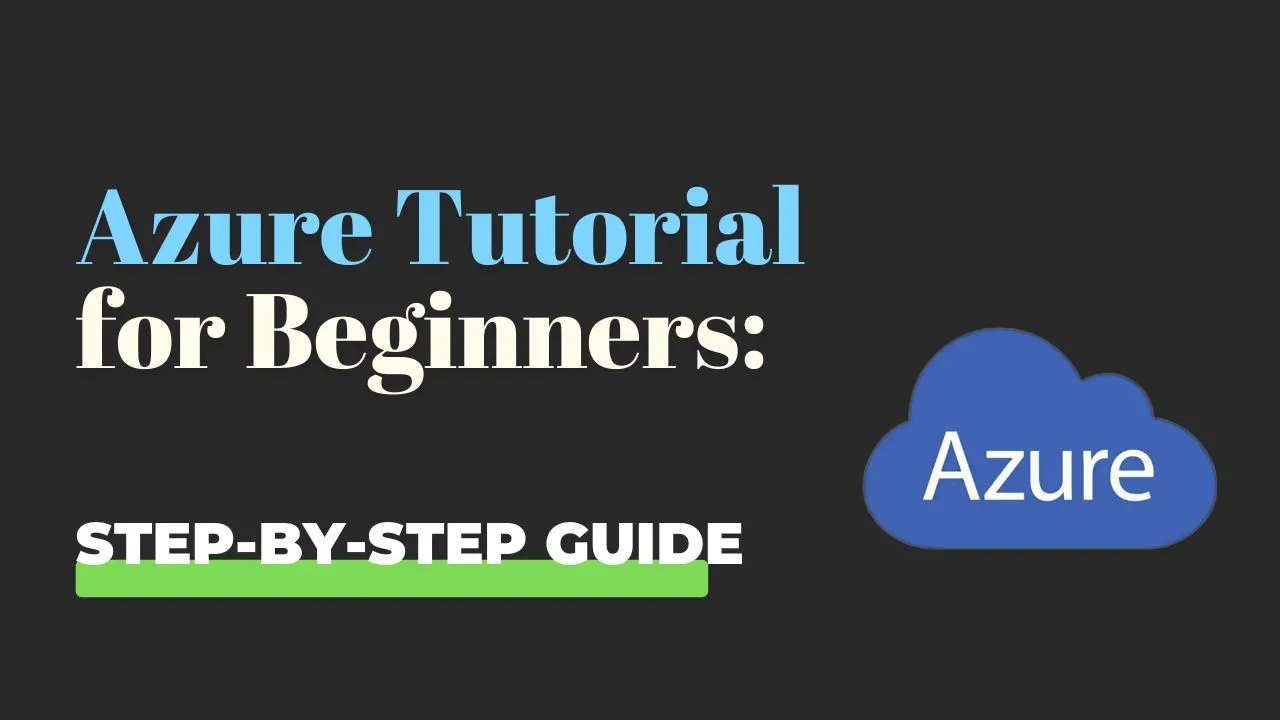Azure Tutorial for Beginners: Step-by-Step Guide
Introduction
Microsoft Azure has grown at a tremendous rate since its inception in 2012. According to TechCrunch, Microsoft Azure grew 9 percent in 2016, 11 percent in 2017, 14 percent in 2018, and 16 percent in the first quarter of 2019 in terms of its market share. It is growing continuously in the number of services as well; it currently offers around 600+ services. But, is it necessary to know all the Azure services? Let me help you figure that out in this Azure tutorial!
In this Microsoft Azure tutorial, you will learn Azure from the basics, so you can get a head start in your Azure cloud career. Azure is a top Cloud Computing platform that comes from the Microsoft stables. In this Azure tutorial, you will learn about the architecture of the Azure cloud, various Azure products, and how enterprises are harnessing the power of Azure in computing, Azure Storage, database, networking, and content delivery. Hence, from this tutorial, you will get a clear idea of how Azure is revolutionizing the cloud domain.
What is Microsoft Azure?
First, let us compare Azure with the market leader, AWS, in Cloud Computing:
| Comparison Criteria | Microsoft Azure | Amazon Web Services |
| Ease of use | Good | Average |
| Hybrid strategy | Excellent | Average |
| Range of products | Limited | Overwhelming |
| Windows compatibility | Excellent | Good |
Azure is the flagship cloud service offered by Microsoft and is today one of the fastest-growing Cloud Computing services. Azure offers services on a pay-as-you-go pricing model in computing, web services, data storage, analytics, networking, content delivery, identity and access management, and even the Internet of Things.
Why is Microsoft Azure so widely used?
Azure is growing at a very fast rate and is trying to close the gap between itself and the market leader AWS in the cloud domain. There are some distinct features of Azure that are making it grow so fast in the cloud domain. In this Azure tutorial, we have listed some of the top reasons why Azure is being so widely used even though it is such a late entrant in the cloud domain:
- Azure offers a very good Platform as a Service (PaaS) with excellent tools and building blocks.
- It offers compatibility with .NET programming languages which is a great advantage.
- The security and data protection feature of Azure is second to none in the cloud domain.
- Azure offers excellent hybrid cloud features and easy migration from on-premise to cloud.
- It gives an integrated environment for app development, testing, and deployment in the cloud.
- You can learn Azure without any hassles and successfully set up an Azure cloud infrastructure.
- Azure has enterprise agreements with Windows users making it easy for them to migrate to Azure.
Features of Microsoft Azure
Here, we list some of the top features of Azure that are forcing enterprises of all sizes to move to the Azure cloud infrastructure:
- Azure search can be used to embed search functionality into any custom application.
- Azure ExpressRoute offers a direct connection between Azure data center and your on-premise environment.
- Secure, dedicated access to Redis cache is possible with Azure Redis Cache.
- Azure Batch lets you effortlessly run and execute your applications like an assembly line.
- Azure Data Factory lets you seamlessly work on the on-premise or cloud infrastructure.
- Azure Load Balancer is a cloud-based system that accepts client requests, determines which machines in the set can handle them, and then forwards those requests to the appropriate machines.
Top Azure Services
Here, we will list some of the top Azure services available:

- Computing: The computing services offered by Azure are for managing virtual machines and supporting remote applications, containerization, and batch processing.
- Web: The web services offered by Azure include those used for the development and deployment of web applications, along with the services for search, API management, and content delivery, among others.
- Storage: Azure offers a whole range of services for scalable cloud storage for both structured and unstructured data. This support is available for the persistent and archival storage of big data.
- Networking: Azure virtual network services are offered for establishing dedicated connections and gateways and also for load balancing, traffic management, DNS hosting, and network security.
- Analytics: The range of analytical services offered by Azure includes Big Data Analytics, real-time analytics, Machine Learning, IoT, and data warehousing, among others.
- Content Delivery: Azure offers services for globally distributed networks for content caching, on-demand streaming services, media playback, encoding, and so on.
- Identity and Access Management (IAM): The Azure IAM services ensure authorized access to the Azure network, encryption, protection of sensitive information, Azure Active Directory, and so on.
- Hybrid Integration: Azure offers services in on-premise infrastructure in connection with Azure data centers, server backup, and recovery.
Applications of Azure
Since the move toward the cloud is unstoppable, in this section of the Azure tutorial, we will see the various applications of Azure.
- Development: Azure helps in successful software development by assisting with code sharing, testing applications, troubleshooting, software development kits, and so on.
- DevOps: Azure DevOps offers a complete set of tools and services for DevOps implementation that includes application diagnostics, test labs for build testing, experimentation, Visual Studio Team Services, and so on.
- Machine Learning: Machine Learning applications offered by Azure include those used for creating powerful AI and cognitive computing models, datasets for training the models, and so on.
- Containerization: Containerization services include the Azure platform for Docker and Kubernetes implementation for creating and orchestrating huge volumes of containers.
- Internet of Things: Azure offers multiple services for capturing, monitoring, and analyzing the IoT data that emanates from sensors and other devices, and then for analyzing and monitoring issue notifications and support for the successful IoT implementation.
- IT Security: This includes identifying and responding to IT security in the cloud and also managing sensitive assets and encryption keys.
Go through our blog on What is Azure Kubernetes blog to learn more.
Why should you learn Azure?
Azure is growing rapidly and is the fastest-growing cloud platform in the world. Since it is a new offering from Microsoft, we can expect the company to grow at an accelerated pace well into the future. All this means, that there will be a huge number of job opportunities for professionals who are trained and certified in Microsoft Azure. This means, if you go through this Azure tutorial and master it, then you will have a basic understanding of this powerful cloud platform which will naturally help you fast-track your career in the cloud domain.
This Microsoft Azure tutorial further covers the introduction to Microsoft Azure, the definition of Cloud Computing, advantages and disadvantages of Cloud Computing, constructing Azure Virtual Machines, hosting web applications on the Azure platform, storing SQL and tabular data in Azure, storage blobs, designing a communication strategy by using queues and the service bus, and Azure Resource Manager.
Recommended Audience
Anybody who wants to make a career in the cloud domain can go through this Azure tutorial and learn Azure in an easy yet effective manner. IT and Software Developers, System Administrators, Project Managers, and others can benefit from this Azure tutorial.
- This blog post was originally published at: Cource
#azure #microsoft
